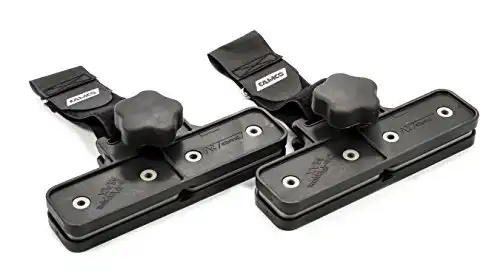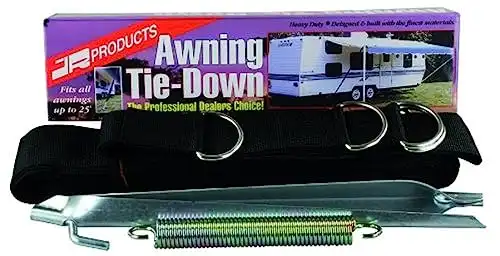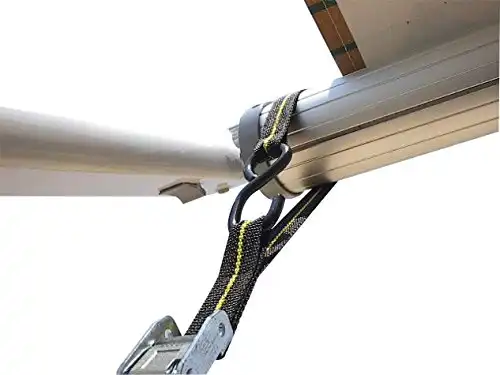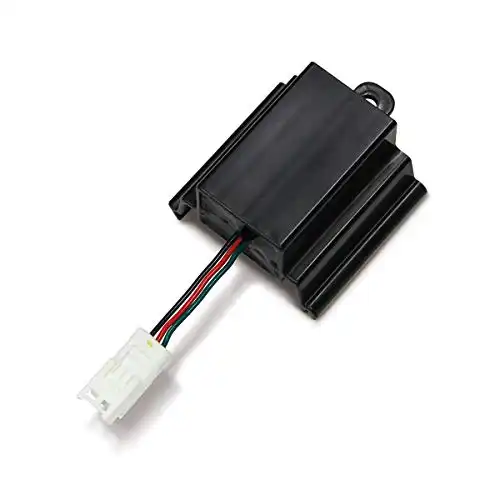Almost every RV comes standard with an awning. Awnings are great for keeping your campsite shady or keeping things dry in a small rain shower. Unfortunately, most RVers have to decide to retract the awning or keep it extended. This information is relevant if you have a manual awning or an electric awning. Some common questions related to this include:
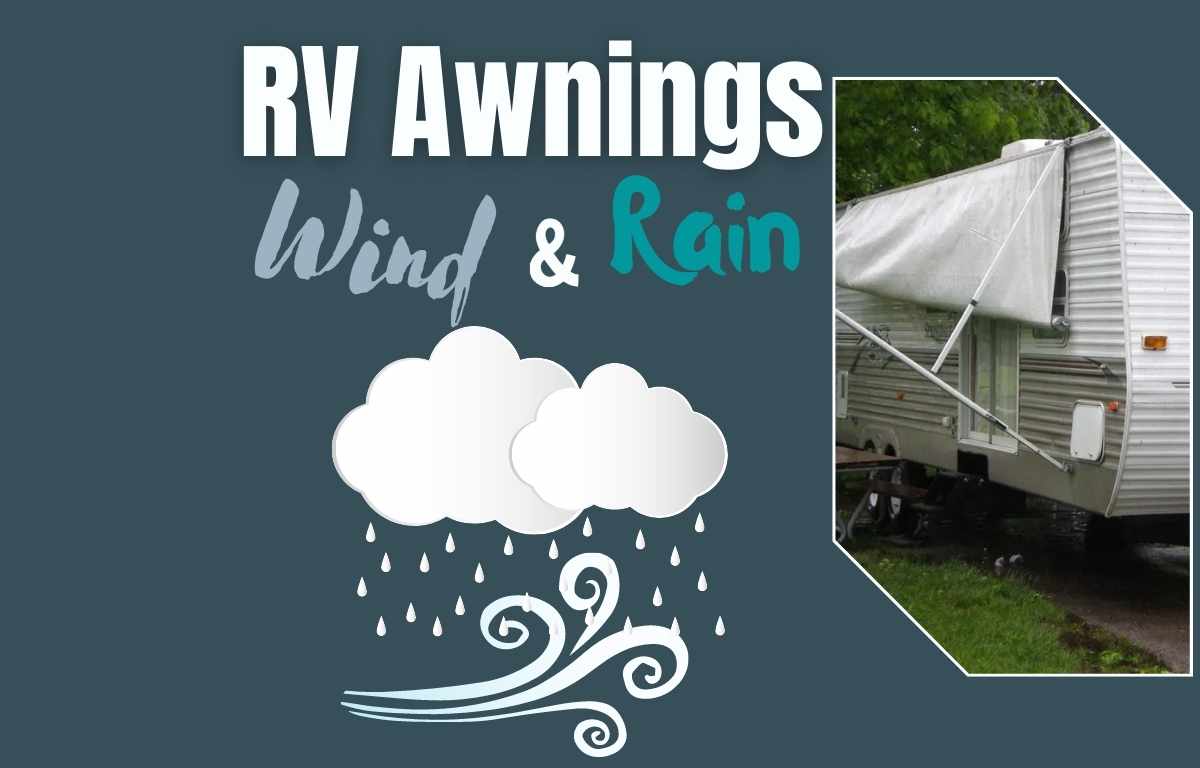
- Can I keep my awning out when I leave the campsite?
- Do I need to retract my awning if it rains?
- Is it too windy for my RV awning?
- What happens if I leave my awning out during a storm?
- How much wind can an RV awning withstand?
If you have any questions like the ones above, you’re not alone. RVers frequently have to decide when it’s safe to keep their awning extended and when to retract it. Below, we’ll try to answer some of these questions. First, however, it’s always a good idea to bring it in when in doubt. Your awning won’t get damaged when retracted, but it can if left extended.
In this article, we’ll cover many of the key steps to protect your awning from being damaged by wind and rain. However, below is a quick overview of the most important steps to take to prevent damage. We’ll cover each of these areas in a lot more detail later in the article.
Awning Wind and Rain Quick Tips:
- Retract Awning: It’s always safer to retract your awning when in doubt. A retracted awning won’t get damaged, but leaving it extended can lead to damage. It’s advisable to retract the awning when away for extended periods, especially during unpredictable weather conditions like thunderstorms.
- Awnings and Rain: Most RV awnings can handle light rain, but it’s advisable to retract them in heavy rain or thunderstorms. Adjusting the awning’s pitch can help water runoff and prevent pooling.
- Rain Dumps: Some awnings have a rain dump feature that allows water to drain if it collects on the awning. This is a safety feature and should not be the primary way to deal with rainstorms.
- Awnings and Wind: Awnings should never be left open in strong winds as they can easily get damaged. Thunderstorms and windy conditions can quickly cause damage, so it’s recommended to keep the awning retracted.
- Awning Stabilizers and Accessories: While there are accessories to provide extra stability, they cannot prevent damage from powerful storms. Choosing accessories that are easy to remove is recommended.
RV awnings and rain
Most RV awnings can handle light rain. Therefore, they serve as great options for allowing you to remain outside if a small rain shower rolls through your campsite. However, there are limits to what’s safe for your awning.
The first thing to consider is the type of storm rolling through your campsite. If the storm is just a small rain shower, most vinyl awnings will handle it just fine. However, if it’s a thunderstorm with heavy rain or gusty winds, you probably want to retract it.
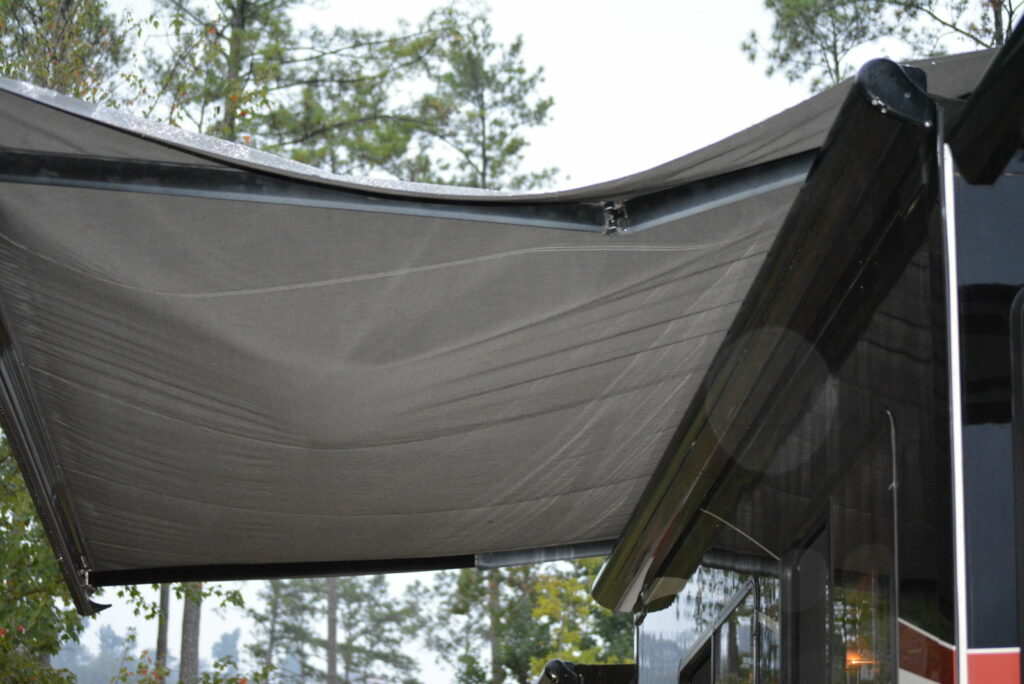
Awning pitch
Some awnings will allow you to adjust the pitch of the awning. The steeper the degree angle, the easier it will be for water to run off. The lower the pitch (flatter and more horizontal), the more water will collect on the awning (potentially causing it to buckle. Near horizontal awnings can easily collect water, creating pools on the awning and causing it to buckle.
Some awnings will also allow you to lower one side, allowing it to have a steeper pitch to shed water more easily. If a rainstorm is approaching and you decide to keep your awning out, consider lowering one side of the awning to prevent water from collecting on it.
Rain Dumps
Some awnings also have a rain dump feature. This safety feature means that if water collects on the awning, the weight will force one or both supports to lower and allow the water to drain. While not standard on all awnings, it helps to protect your awning if you forget to retract it. It’s best to rely on this as a safety feature rather than the primary way to deal with rainstorms.
Awnings and wind
One of the most dangerous situations for awnings is high winds and wind gusts. You know that wind can be powerful if you have ever tried to carry an open umbrella on a windy day. When windy, your awning can act as a big umbrella with a lot of surface area, and it will only take a brief gust to pull up your awning and slam it back down. Since many awnings are large, this situation can easily tear the awning from the connection to the crossbar or even damage your supports. Both of these issues can be time-consuming and expensive to repair. In short, your RV awning should never be left open in strong winds.
Thunderstorms and awnings
While thunderstorms can be brief, they’re usually powerful and can quickly cause awning damage. Therefore, whenever you see a thunderstorm in the weather forecast, it’s best to retract your awning before it rolls through. If you forget, you may get lucky, and your awning will survive. However, it’s a gamble that’s typically not worth taking.
Windy days
On windy days, it’s best to leave your awning retracted. It’s near impossible to predict when a big gust of wind will blow through and be too much for your awning. If the forecast is calling for windy conditions, don’t take any chances leaving your awning extended (especially if you’re away from the RV). Even low MPH winds can damage an awning. While a steady wind can create problems, it’s the irregular wind gust that can take down an awning in seconds.
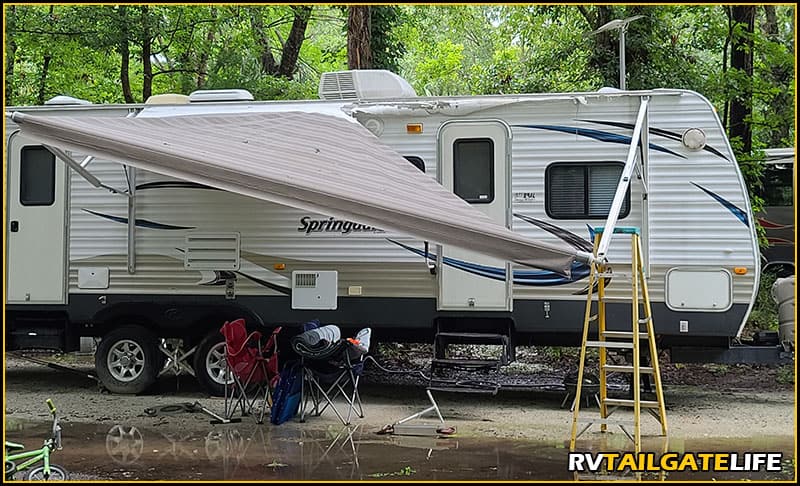

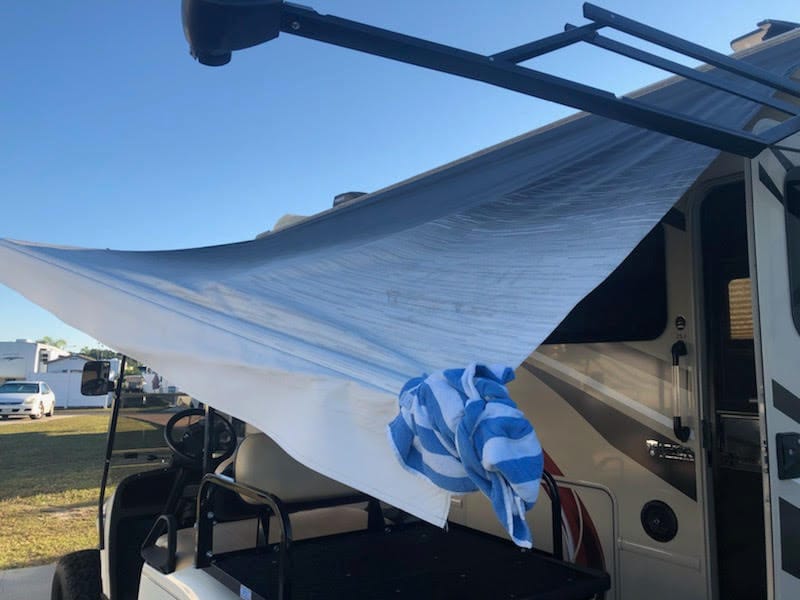
Light winds
Most RV awnings are designed to withstand light wind or a breezy day. However, most RV owners will struggle to determine when it crossed the line from light to too much. However, if you have your awning extended and you can hear the occasional flapping of the awning as a breeze kicks up, your awning should be fine (even for little gusts of wind). There are some accessories that RVers use to help quiet their awning flapping (read below). Wind can cause a lot of damage (expensive) to RV retractable awnings. At best, you may get a small tear in your fabric awning that can be patched with awning repair tape. At worst, wind can break the awning arms or cause other structural damage. The last thing you want to deal with on a camping trip is a torn-off awning.
Making the decision when the wind is too strong from your awning is a judgment call. Since wind is unpredictable, there’s no resource out there that will be able to tell you when it’s time to roll up your awning. I tend to rely on a few indicators that it’s time to pull in the awning. First, if it sounds like the occasional flap is getting steadier, I’ll bring it in. Additionally, I’ll bring the awning in if I notice anything starting to blow around outside (grill covers, outdoor carpets, trash, etc.). Also, take note of your campsite and consider where you’re camping and the wind direction. Camping in windy areas or open areas will usually have higher wind speeds, even on a seemingly calm day. A great time to reduce the chance of wind damage is when choosing a campsite. If you have the choice, opt for one with trees (even small trees) to break up the force of the wind. If you camp next to high-profile vehicles, such as a class A motorhome, this can also help.
RV awnings when you’re away from the RV
When I’m away from my RV, whether I’m away at work for the day or taking a day trip on vacation, I typically retract my awning. I do this more out of a precaution for the unknown. I have left it out on multiple occasions, and nothing happened. However, I also had an unfortunate experience where a thunderstorm rolled through and caused my awning to collapse. I quickly learned my lesson and now retract it whenever I’m away for an extended period.
However, If I’m only leaving for a few hours, I’ll typically check the forecast and decide to leave it extended or retract it. When thunderstorms can creep up with little notice during the hot summer months, I’ll usually bring it in. However, If I need to run to the grocery store and all seems calm, I may leave it out.
This is a decision you have to make for yourself. Of course, it’s always safest to keep it retracted to avoid unforeseen issues. But, on the other hand, don’t stress about it too much. Use good judgment, and you should be safe.
Awning stabilizers and accessories
While there is no shortage of awning accessories claiming to stabilize or protect your awning from wind and rain, nothing can prevent damage from a powerful storm. These accessories are intended to provide more protection, extra stability, or quiet awning noise. The other thing to remember about using accessories is that you’ll need to remove them before retracting your awning.
If you decide to purchase an awning stabilizer or wind guard, I advise you to choose one that’s easy to remove. If you need to spend a lot of time removing it if a storm is rolling through, you may find it more of a pain than it’s worth.
However, many people like to use them and find that they can be a great accessory for camping. Let’s take a look at some of the more popular options available.
Camco Awning De-Flapper Max
The Camco RV Awning De-Flapper Max is designed to protect the awning from tearing from repeated flapping. It will also reduce noise by keeping your awning more stable in light wind. The de-flapper clamps connect directly to the awning fabric and then strap to the awning arm, creating a taut awning fabric that will be less prone to wind flapping it around.
Some of the downsides that people complain about with the product are needing a ladder to reach the de-flapper to install and remove it. Other people express concern over the strap being too long or not long enough. Finally, some people need to modify the straps to get the right fit.
Awning Tie-down kits
The idea of an awning tie-down is to create a solid connection between the awning and the ground, preventing a wind gust from pulling up the awning and slamming it back down (the action that causes the greatest damage to an awning). Most tie-down systems function similarly- they connect to the awning frame and have a strong cord that connects a stake to anchor it into the ground (some stakes are more sturdy, like spiral stakes like a dog tie).
While they work to prevent damage, they are not foolproof and can provide a false sense of security in a strong storm with heavy wind conditions. Also, they will need to be removed whenever you retract your awning. If you’re handy, you can also create your own DIY awning anchors.
On the plus side, they do work and can prevent costly damage if an unexpected wind gust gets hold of your awning. Below are several great tie-down options:
25-foot Awning Tie Down
Camco 42593 Awning Anchor Kit with Pull Tension Strap
Wind sensor kits
Solera 715123 Wind Sensor Kit Smart Arm
If you’re lucky enough to have a Solera awning with smart arms, you have a great accessory that can protect your awning from wind damage. Lippert makes an easy add-on sensor for some electric awnings. While only compatible with 12V Smart Arm awning hardware, the sensor will automatically retract your awning in the event of increased wind speeds. It installs in minutes and is pretty much plug-and-play.
Sensors like this are becoming more common on higher-end RVs, and I expect to see this become more common over the years. If you have the correct configuration, this may be a great accessory to add some peace of mind to your RV.
Conclusion
RV awnings are a great addition to your RV, making your campsite more comfortable and enjoyable. However, they can also be a concern if not protected during stormy conditions. Both wind and rain can damage your extended awning. If you anticipate windy or rainy conditions, your best bet is to retract your awning. However, this isn’t always possible or convenient. With a little experience and using good judgment, you can know when it’s necessary to retract your RV awning.

